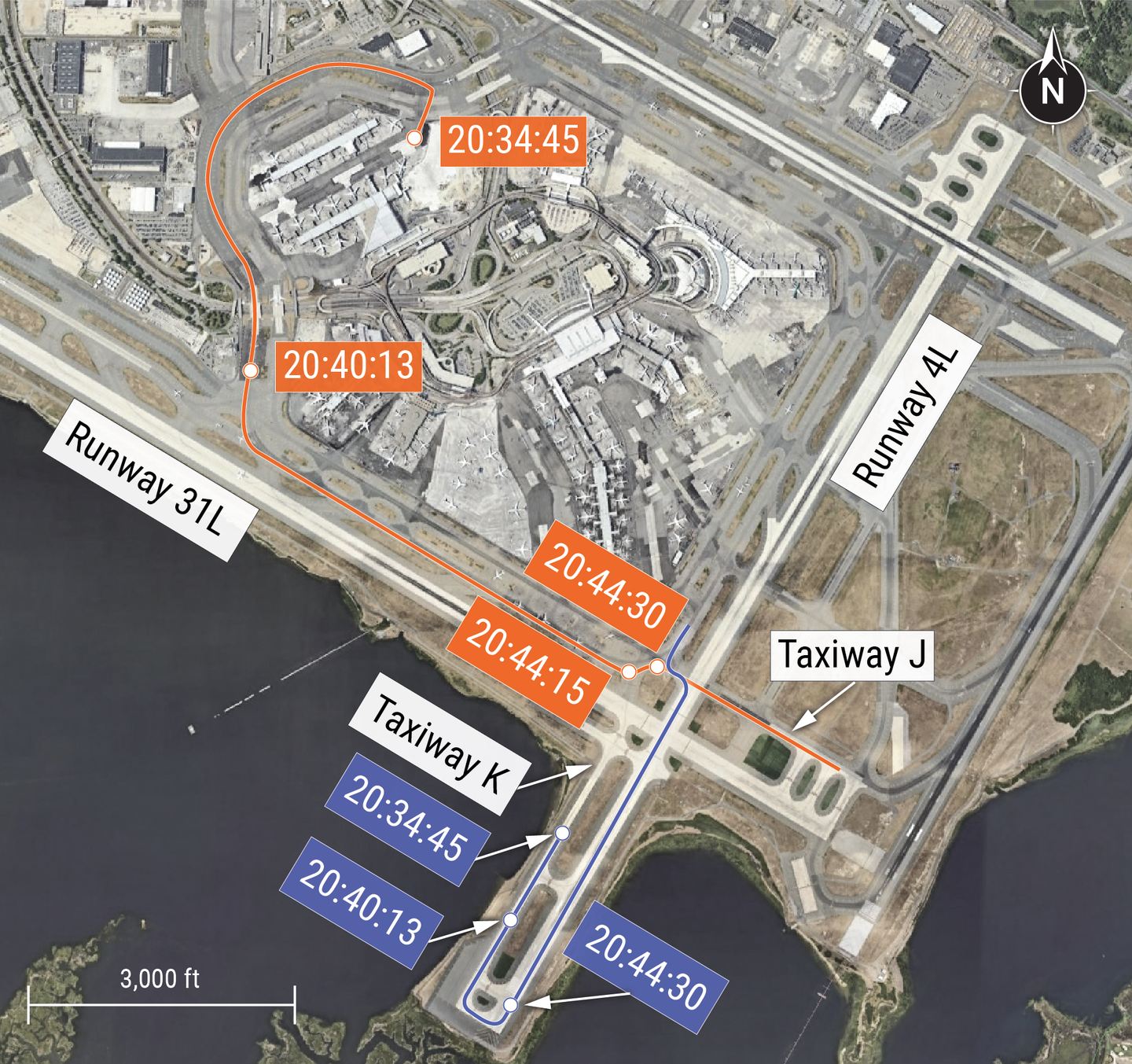NTSB: Interruptions, Multitasking Cause of JFK Near Collision
The incident prompted a call from the safety agency for cockpit voice recorders to be required to cover the last 25 hours of audio instead of two hours.

The taxi paths of the American B-777 (orange, terminal through taxiway J) and the Delta B-737 (blue, taxiway K and Runway 4L), based on ADS-B data, with times annotated at select locations. Satellite image annotated by NTSB. [Courtesy: NTSB]
Interruptions and multitasking resulted in distractions that caused a Boeing 777 crew to cross a runway and nearly collide with a Boeing 737 at John F. Kennedy International Airport (KJFK) in New York last year, according to the National Transportation Safety Board (NTSB).
In a preliminary report released Tuesday detailing the January 2023 near collision, NTSB said confusion on the part of the crew of a London-bound Boeing 777 led to mistakenly crossing a runway occupied by the Delta Airlines 737 that had been given clearance for takeoff. The aircraft came within 1,000 feet of each other.
Numerous Factors
On the evening of January 13, 2023, Delta Airlines Flight 1943 bound for the Dominican Republic was cleared for takeoff from Runway 4L at KJFK. The jet was carrying 145 passengers and 14 crew. Runway 4 is perpendicular to Runway 31.
Shortly before 9 p.m., the B-777 moved along a taxiway when it approached the area where two runways cross perpendicularly, Ross Feinstein, a former spokesman for both the Transportation Security Administration and American Airlines, said at the time after reviewing radar and audio recordings.
An audio recording of an air traffic controller can be heard telling the B-777 to “cross Runway 31 Left,” which would require it to turn right before coming around to line up for departure on Runway 4 Left behind the Delta B-737.
The B-777 made a wrong turn, putting it on Runway 4.
As the B-737 accelerated, Airport Surface Detection Equipment, Model X (ASDE-X) issued aural and visual alerts in the ATC tower, warning of a potential collision. Five seconds after the alerts, the controller canceled the takeoff clearance of the Delta B-737, which quickly decelerated from its top speed of 121 mph as the American Airlines B-777 was crossing in front of it.
The NTSB investigation found the ground controller who provided the taxi instructions to the American B-777 crew didn’t notice the aircraft turned onto the wrong taxiway because he was performing a lesser priority task that involved looking down. The ATC tower team, which was involved with operations related to switching runways, also didn’t prioritize its duties to continuously scan the airport operations environment and did not notice the B-777 on the runway.
NTSB investigators cited numerous factors that contributed to the American Airlines captain’s mistake in continuing along the wrong taxiway and crossing the occupied runway without a clearance, including interruptions and multitasking that were happening on the flight deck during critical moments of ground navigation. The other two flight crewmembers didn’t catch the captain’s error because they were both engaged in tasks that diverted their visual attention from outside the airplane.
The investigation also identified safety issues with air traffic control.
NTSB Safety Recommendations
As a result of the event and subsequent investigation, the NTSB made the following recommendations to the FAA to address the risks identified in this investigation:
- Encourage flight crews to verbalize the number of the runway they are about to cross, unless an automated system already provides an advisory.
- Encourage air carriers to use their safety management systems to identify flight crew surface navigation errors and develop effective mitigation strategies.
- Evaluate the effectiveness of the activation logic for runway status light systems, and update the logic as necessary to improve its effectiveness.
- Collaborate with aircraft and avionics manufacturers to develop a system that would alert flight crews of traffic on a runway or taxiway and traffic on approach to land, and require that both newly manufactured and existing transport category airplanes have such a system installed.
- Update a long-standing recommendation to require all airplanes be fitted with a cockpit voice recorder (CVR) capable of covering the last 25 hours of audio, up from the current standard of two hours.
The CVR information was not available for this incident because the data was overwritten. As a result, the NTSB had to rely exclusively on flight crew recollections about the incident, however, these were not documented until a month after the incident occurred.
A cockpit voice recording would likely have provided additional details about the content and timing of crew communications, shed light on the crew’s minute-by-minute focus of attention, and revealed any unreported, nonpertinent conversations or other distractions.
“The whole reason U.S. aviation has such an exemplary safety record is because we’ve built in extra layers of protection, which is why we need lifesaving technology at more of the nation’s airports,” NTSB Chair Jennifer Homendy said in a statement. “Our investigation also makes clear why we’ve long supported systems that warn flight crews of risks directly: because every second matters. Thankfully, the controllers acted quickly in this case, but safety shouldn’t be all on their shoulders. Instead, we must back up every single component of the system; direct crew alerts do just that.”
The investigation abstract is available here. The NTSB expects the final report to be published later this year.

Sign-up for newsletters & special offers!
Get the latest FLYING stories & special offers delivered directly to your inbox






